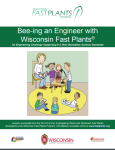Bee-ing an Engineer
Download this complete set of lessons for an elementary, NGSS-aligned inquiry that foregrounds engineering practices. During the days that are supported by this investigation, students observe flowers on their 14 to 16 day old Fast Plants along with bee structures, learning to connect how the shape of a structure is related to its function. Then, students make and/or use bee sticks to conduct pollination. Finally, students look closely at how pollen is carried on bee bodies and where pollen moves within the flower as concrete examples of the relationship between structure and function. Then, students have the opportunity to use a wide variety of materials to design a solution to a problem (no bees). The solution will be a simple model that mimics the function of a bee in pollinating plants.Complete kits are available from Carolina Biological for this investigation, or everything to grow Fast Plants can be built or obtained locally, using the instructions available on the Fast Plants website.
This stand-alone inquiry is a subset of lessons from a comprehensive life cycle unit that is NGSS-aligned, titled "Investigating Plants Needs with Wisconsin Fast Plants" (also available in the Fast Plants digital library).
- Instructional Material -- Activity (DCMI Type Vocabulary)
- Instructional Material -- Lesson/Lesson Plan (DCMI Type Vocabulary)
- Instructional Material -- Unit of Instruction (DCMI Type Vocabulary)
- Instructional Material -- Experiment/Lab Activity (DCMI Type Vocabulary)
- Instructional Material -- Instructor Guide/Manual (DCMI Type Vocabulary)

Comments